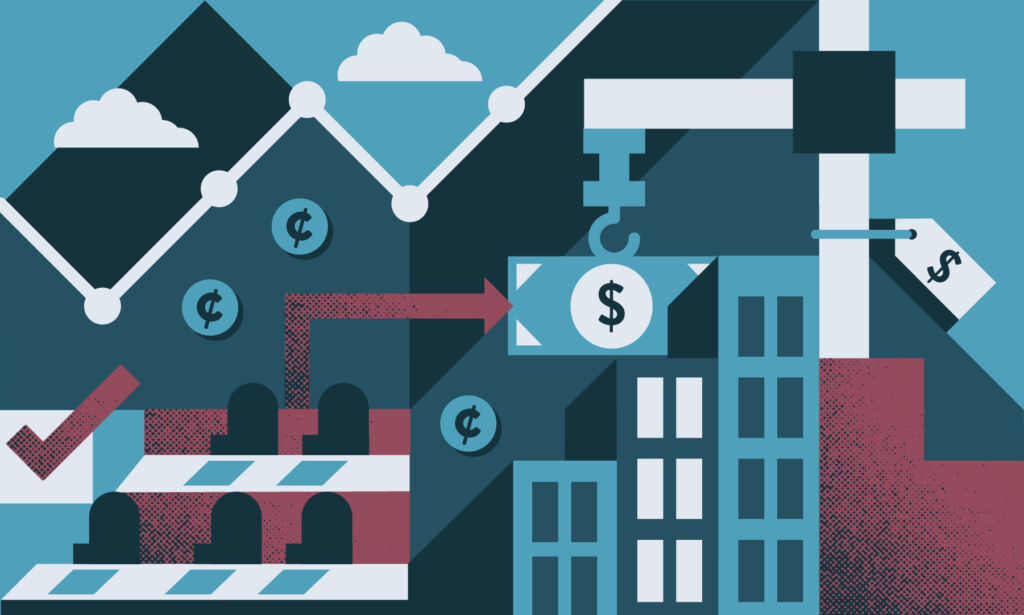On Feb. 24, Jason Kenney’s United Conservative Party government tabled its fourth budget. It is the first balanced budget the provincial government has presented since 2015, estimating a surplus of $511 million in 2022-23.
Here are 10 key takeaways from the 2022 budget:
1. This budget was tabled after a year of rising oil prices—they’ve increased by 64% over the past year. In January 2021, the price of oil obtained by Alberta producers was about $40/barrel; by January 2022, it had risen to nearly $66/barrel. For every one dollar increase in the price of oil, provincial revenue in Alberta increases by approximately $500 million annually, a phenomenon that creates enormous fiscal capacity for Alberta’s provincial government.
2. Due largely to rising oil prices, the provincial deficit has been temporarily tamed. This time last year, the Kenney government had been projecting an $11 billion deficit for the 2022-23 fiscal year. Currently, it’s projecting a surplus of $511 million for the same fiscal year.
3. Alberta remains Canada’s lowest-taxed province. Here’s a direct quote from the budget document: “Alberta continues to have an overall tax advantage compared to all other provinces, with no sales tax, payroll tax or health premium. In 2022-23, Albertans and Alberta businesses would pay at least $14.8 billion more in taxes if Alberta had the same tax system as any other province.” Higher taxes over the past several years would have created less of a deficit to begin with.
4. The budget appears to try to pass off at least one federal investment as being provincial.Specifically, it announces $666 million in funding for 2022-23 for the recently signed Canada-Alberta Early Learning and Child Care agreement (a five-year agreement signed in November 2021); but this $666 million is federal money.
5. The budget signals a shift away from government-owned housing, in favour of housing owned by non-profits.The budget announces $118 million in capital funding, over three years, for affordable housing in general. According to the budget document, this is intended “to begin implementation of Stronger Foundations: Alberta’s ten-year strategy to improve and expand affordable housing.” But three caveats are in order here. First, this is being financed in part by $90 million from the sale of provincially-owned housing assets (i.e., housing that has fallen into disrepair). Second, most of this funding is being back-ended: $20 million for 2022-23, $39.9 million for 2023-24, and $58.1 million in 2024-25. And third, the Capital Investment budget for the Alberta Social Housing Corporation (i.e., provincially-owned housing) for 2022-23 announces a 50% reduction compared to the previous year.1
6. The new capital funding for housing will include a modest increase, specifically for Indigenous peoples. I’m referring to $20.7 million, over three years, for the Indigenous Housing Capital Program. For perspective, it costs about $200,000 to create one new unit of non-profit housing, and that does not include the cost of the ongoing subsidy required by the government once it’s built.
7. A very small amount of new money will be made available to operate existing housing. I’m referring to $25 million over three years. This will be back-ended as follows: $1.8 million for 2022-23, $4.2 million for 2023-24, and $19.3 million for 2024-25. Much of this will go toward rent subsidies for low-income households.
8. Even though homelessness will likely rise, no new funding was announced for prevention. Research has demonstrated that high oil prices are correlated with higher rates of homelessness, due to higher rent levels and lower rental vacancy rates created by an inflow of workers to Alberta. So if oil prices remain high in Alberta, there will almost certainly be more homelessness. Increased provincial investment in homelessness prevention would have been timely.
9. Despite high inflation, social assistance benefit levels will remain at current levels.It’s worth noting that a single adult on welfare (i.e., Income Support) in Alberta receives less than $9,000 per year to live on, which has 4.8% less purchasing power than it did a year ago. With this meagre amount of money, they must pay for housing, food, transportation and other basic needs. What’s more, lower social assistance benefit levels are associated with more homelessness and reduced food security.10. In spite of the overdose crisis, no new money was announced for harm reduction. By harm reduction, I mean the reduction of harm associated with drug use, while not necessarily requiring complete abstinence. However, it’s no secret that this government is not a strong supporter of harm reduction. Opioid-related deaths in Alberta have grown dramatically during the pandemic. Furthermore, the overdose crisis (i.e., drug poisoning) is hitting First Nations much worse than the rest of the population.
In sum: Despite turning the corner on the deficit and remaining Canada’s lowest-taxed province, this budget misses an important opportunity to increase investment in several important areas—including social assistance, homelessness and harm reduction. The new investments announced for housing merit a modest degree of praise. With oil prices rising, now would be a very good time to start thinking about making enhancements to social investment over the long term.
1. For detailed analysis of changes to these and other housing investments, see this overview.
The author wishes to thank for following individuals for assistance with this blog post: Laurie Adkin, Bob Ascah, David Climenhaga, Martha Friendly, Elaine Hyshka, Ron Kneebone, Sylvia Regnier, Christopher Smith, Trevor Tombe and several individuals whose anonymity is being preserved.







